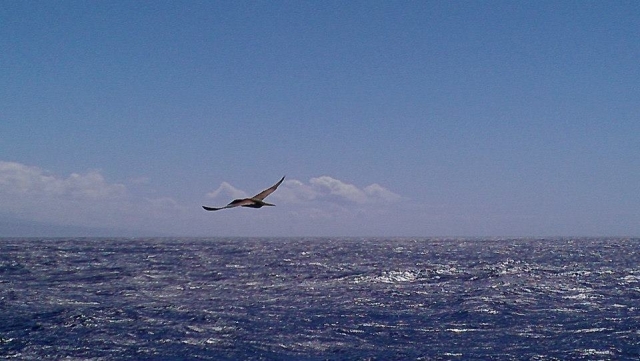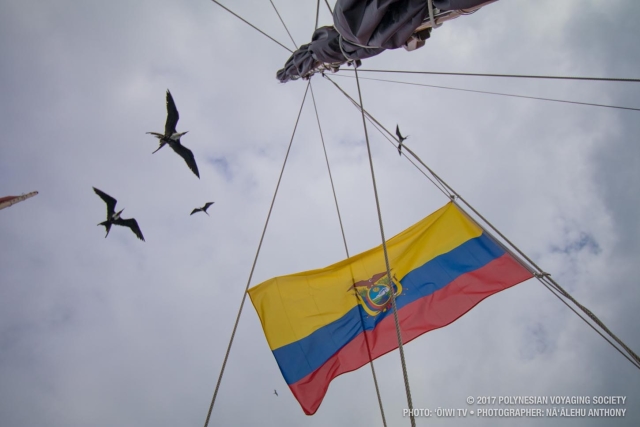
Crew Blog | Sam ʻOhu Gon: Hawaiians exploring a new world
- Posted on 7 Feb 2017
- In Crew Blogs, Featured, Malama Honua Selects, Newsletter
By Sam ʻOhu Gon III
Imagine arriving by voyaging canoe to an island for the first time, and while circling the dry coastline intent on a place to land, the eyes moved from the dusty grey dryness of the leeward lowlands up into the kua uli, the dark lush, vegetated uplands, knowing well that in that zone would be forest, ferns, bird life, perhaps flowing water, all the markings of the wao akua, the sacred realm occupied by the gods.
The lāʻau lapaʻau of the crew would fully expect that even though this was an island they have not seen before, some of the kino of their akua would be present, some of the physical manifestations commonly encountered in their home island would be there: the winter-flushing ferns of Lono, the hardwood trees of Kū and Kāne, the uluhe mat ferns of Hina perhaps. So, with eyes trained for recognizing those kino, they might find themselves climbing into the misty summit of the island with pule and hoʻokupu, eyes ready for the familiar as well as the new. Those familiar forms would immediately be called by their names, while those that were unfamiliar would be examined very closely, the leaves, the form of the tree, its bark, its strength, the form and color of its flower.
The same discerning powers of observation that were required for oceanic voyaging — the tiniest details of the winds, rains, ocean swells, the myriad bird life forms and their individual behaviors and ecologies–would be brought to bear on the living universe of the uplands.
And so, as we explored the Galapagos highlands yesterday with students from Hawaiʻi, we took note that some of the  familiar life forms of home were immediately apparent: ʻalaʻalawainui sitting delicately upon moss-covered branches of forest trees; wāwae ʻiole springing up through the understory with their familiar rat’s foot forms; kīlau pueo prominent as the tallest fern, and assuming rapid dominance in the shrub layer,
familiar life forms of home were immediately apparent: ʻalaʻalawainui sitting delicately upon moss-covered branches of forest trees; wāwae ʻiole springing up through the understory with their familiar rat’s foot forms; kīlau pueo prominent as the tallest fern, and assuming rapid dominance in the shrub layer,  triggered by the start of the Galapagean wet season. Other fern shapes that might have been relatives of species in Hawaiʻi were also apparent, lending the understory a very comfortable, familiar feel. Truly this was a kindred volcanic island of the moana nui. Exploring the shoreline, many of the seabirds soaring overhead were also immediately nameable: ʻiwa gliding
triggered by the start of the Galapagean wet season. Other fern shapes that might have been relatives of species in Hawaiʻi were also apparent, lending the understory a very comfortable, familiar feel. Truly this was a kindred volcanic island of the moana nui. Exploring the shoreline, many of the seabirds soaring overhead were also immediately nameable: ʻiwa gliding
 in the still, humid pre-storm sky, blue-footed ʻā perched on small offshore islets, noio hovering and landing on the manu hope of the canoe. But there were many other birds of shoreand mountain that were not immediately Hawaiian. The small songbirds, including all of the famous Darwin’s Finches, required that we had familiarized ourselves with their forms vicariously, through our research prior to arriving in the Galapagos.
in the still, humid pre-storm sky, blue-footed ʻā perched on small offshore islets, noio hovering and landing on the manu hope of the canoe. But there were many other birds of shoreand mountain that were not immediately Hawaiian. The small songbirds, including all of the famous Darwin’s Finches, required that we had familiarized ourselves with their forms vicariously, through our research prior to arriving in the Galapagos.
And in the midst of this familiarity – so many other things were entirely unfamiliar! Black moʻo greeted the canoe  in the waters near shore, and covered the lava coast in some places, unlike anything we knew at home! Their counterparts of the land were also present, and confirmed the long-appreciated pattern taught by the Kumulipo: that the diversity of life on the land is matched by the life of sea, and that the kuleana of the land is a guardianship relationship. Gigantic tortoises, ʻea pilikua, plodded across the open understory of the highland forest. Such a contrast the dry arid lowlands offered! Nearly all of the plants offered entirely unpleasant arrays of spines. Even the tallest tree of the kekaha wai ʻole, the waterless leeward
in the waters near shore, and covered the lava coast in some places, unlike anything we knew at home! Their counterparts of the land were also present, and confirmed the long-appreciated pattern taught by the Kumulipo: that the diversity of life on the land is matched by the life of sea, and that the kuleana of the land is a guardianship relationship. Gigantic tortoises, ʻea pilikua, plodded across the open understory of the highland forest. Such a contrast the dry arid lowlands offered! Nearly all of the plants offered entirely unpleasant arrays of spines. Even the tallest tree of the kekaha wai ʻole, the waterless leeward  region, was a gigantic panini cactus with an armored trunk that shared some of the same ʻano as an old wiliwili tree… If the Galapagos had been encountered by voyaging Polynesians in the course of the colonization of the Pacific, you can be sure that in a remarkably short amount of time, the names of features of land and sea, including all of the plants and animals, would have been assigned, and their relationships with each other (and to people as but a part of the living universe) would have been explored. It is not only the names of things, after all, but their ʻano, their character, that are important.
region, was a gigantic panini cactus with an armored trunk that shared some of the same ʻano as an old wiliwili tree… If the Galapagos had been encountered by voyaging Polynesians in the course of the colonization of the Pacific, you can be sure that in a remarkably short amount of time, the names of features of land and sea, including all of the plants and animals, would have been assigned, and their relationships with each other (and to people as but a part of the living universe) would have been explored. It is not only the names of things, after all, but their ʻano, their character, that are important.
It is the ʻano of things that captured the eyes of Hawaiʻi ʻimiloa, far-sighted Hawaiians. They would be continually learning, testing what they had been taught through oral tradition, comparing their learnings with others around them that held knowledge, and the accumulation of ʻike would be many generations in both length and depth. As Kepelino said, “Ahu kupanaha ia, Hawaiʻi ‘imi loa!” An incredible storehouse of knowledge, those far-sighted Hawaiians!” And so, as the Worldwide Voyage sweeps toward its culmination, what an incredible storehouse of experiences the crew and all who have been touched by the waʻa have enjoyed!
This experience cannot merely be a matter of a string of experiences gathered along a 60,000 mile voyage, but it must serve as the impetus for the re-establishment of the tradition of Hawaiʻi ʻImiloa: people of Hawaiʻi expert and continually learning in all that they do, knowing the language of the sea and the land, as they would know the most intimate details of their genealogies and their living families. Without this, we cannot establish the relationship with our Island Earth that we will need to achieve the ideal balance to truly mālama honua, to have both our world and our people thrive in harmony. Just as the Worldwide Voyage of Hōkūleʻa has been, it is not an easy course to follow, but it is a necessary one that honors the best of our ancestors.
Sam ʻOhu Gon III is a Senior Scientist and Cultural Advisor at The Nature Conservancy of Hawai’i.
Hōkūle‘a Homecoming – Save the Date
Sign up for updates and be the first to know as we continue to detail homecoming festivities during the week of Hōkūleʻa’s homecoming
on June 17, 2017!






